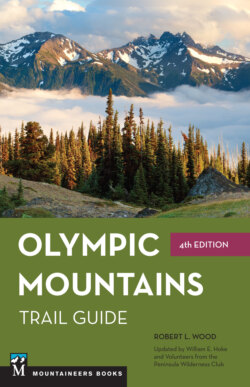Читать книгу Olympic Mountains Trail Guide - Robert Wood - Страница 28
На сайте Литреса книга снята с продажи.
BEFORE YOU GO
ОглавлениеWhen traveling in the Olympic Mountains, every hiker should carry the Ten Essentials. The point of this list, originated by The Mountaineers, has always been to answer two basic questions: Can you prevent emergencies and respond positively should one occur (items 1–5)? And can you safely spend a night—or more—outside (items 6–10)? Use this list as a guide and tailor it to the needs of your outing.
1.Navigation
2.Headlamp
3.Sun protection
4.First aid
5.Knife
6.Fire
7.Shelter
8.Extra food
9.Extra water
10.Extra clothes
You should also consider these hiking safety tips from the Olympic Mountain Rescue organization, before you go.
Tell someone. Leave a note that lists your trailhead, vehicle description, departure time, travel route, anticipated arrival time back home, and emergency contacts. Sometimes hikers get home a little later than expected; so let your party know that if you are not home at the exact time predicted, not to panic or immediately call 911. They should allow a reasonable buffer time prior to contacting authorities.
Check the weather. Get a weather forecast for the area but be prepared for anything, since the Olympics are notorious for extreme weather changes. Sunshine can turn to a blizzard within minutes.
Know first aid. Be up-to-date on your basic first-aid skills, and consider taking a Wilderness First Aid or Wilderness First Responder course.
In an emergency. If you or a hiking partner have an emergency in the mountains involving an injury and are unable to get out, first make sure the injured party is comfortable, then assess what is wrong. Note landmarks that may be useful in describing your location. If it is clear that the injured party is unable to walk, call 911. If there isn’t reception—and many places in the Olympic Mountains do not have reception—get to a place with service. The person taking the call will initiate a search and rescue event, which may involve sheriff ’s deputies, national park staff, and search and rescue teams. Be aware, however, that it can take multiple hours for a rescue party to reach the injured party. Carrying a cell phone or a satellite beacon can greatly speed up the process of communicating the details of an incident to those who can provide help. When considering a satellite beacon, if possible choose a model which features two-way texting features so that the authorities can communicate directly with you.
A NOTE ABOUT SAFETY
Safety is an important concern in all outdoor activities. No guidebook can alert you to every hazard or anticipate the limitations of every reader. Therefore, the descriptions of roads, trails, routes, and natural features in this book are not representations that a particular place or excursion will be safe for your party. When you follow any of the routes described in this book, you assume responsibility for your own safety. Under normal conditions, such excursions require the usual attention to traffic, road and trail conditions, weather, terrain, the capabilities of your party, and other factors. Keeping informed on current conditions and exercising common sense are the keys to a safe, enjoyable outing.
—Mountaineers Books
